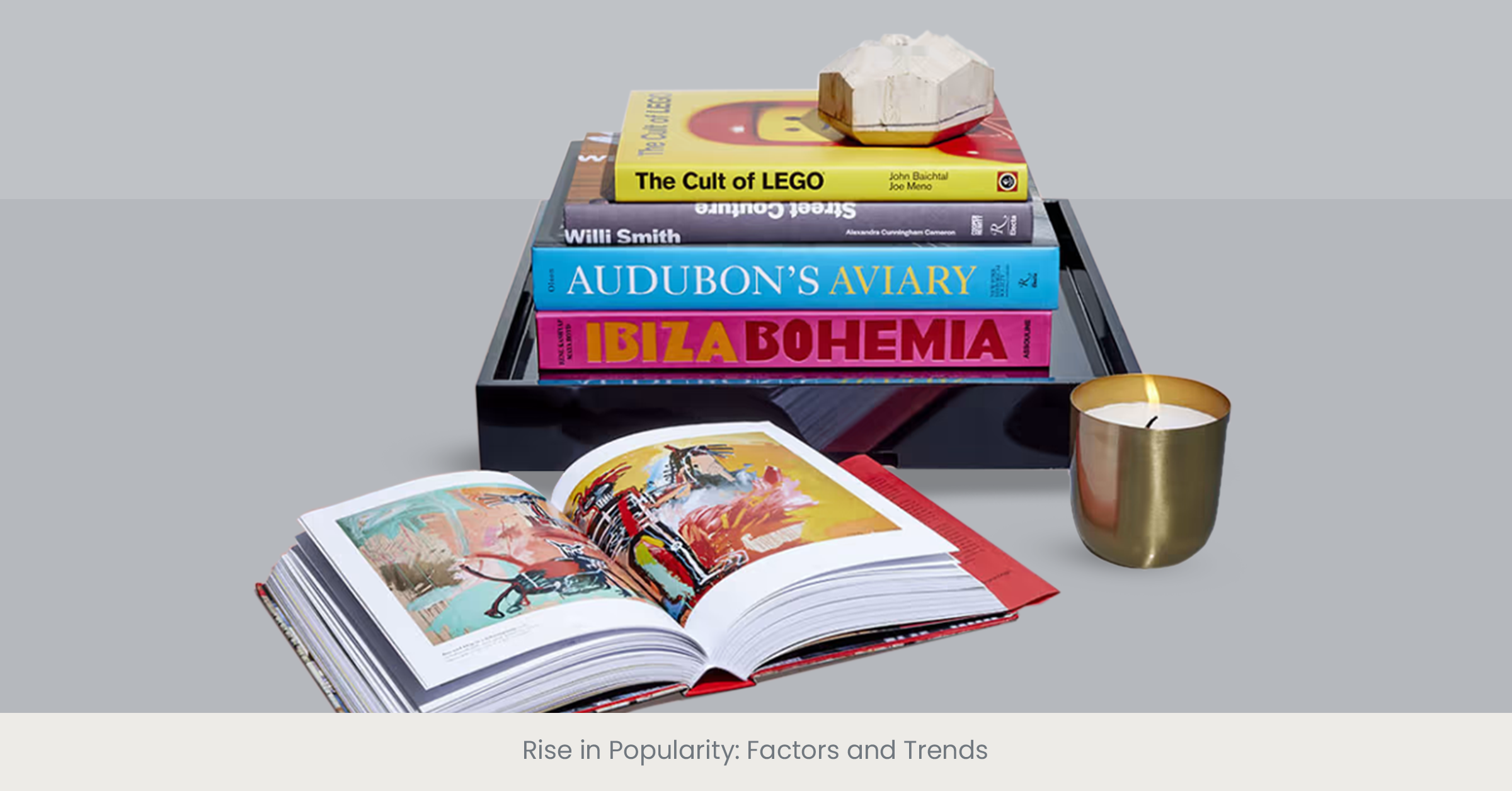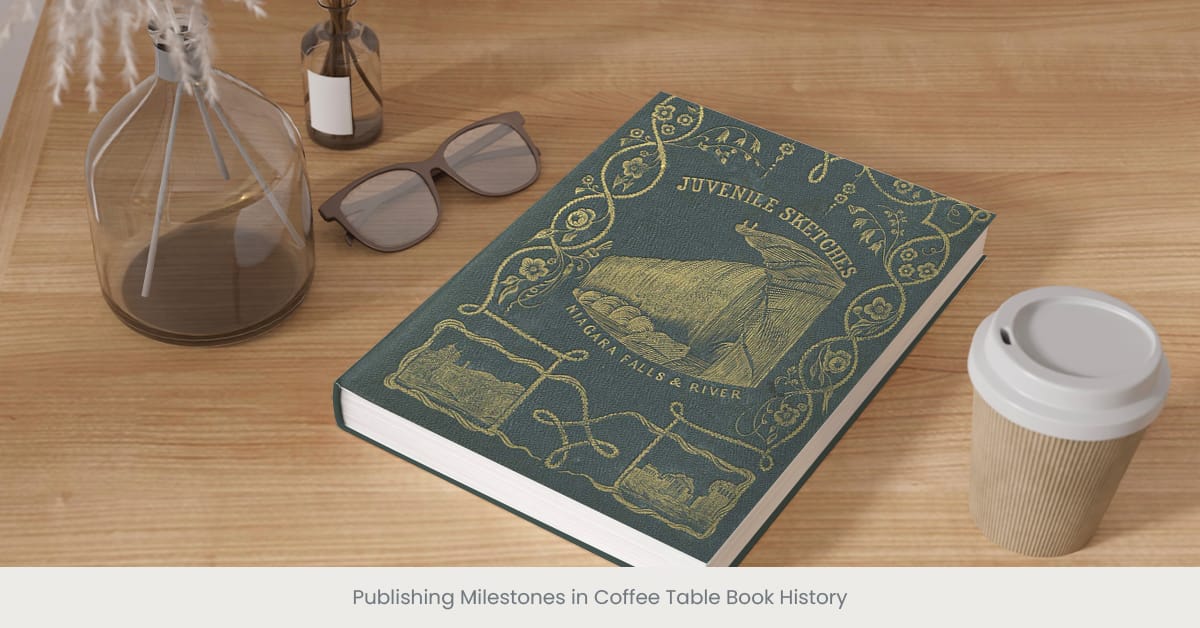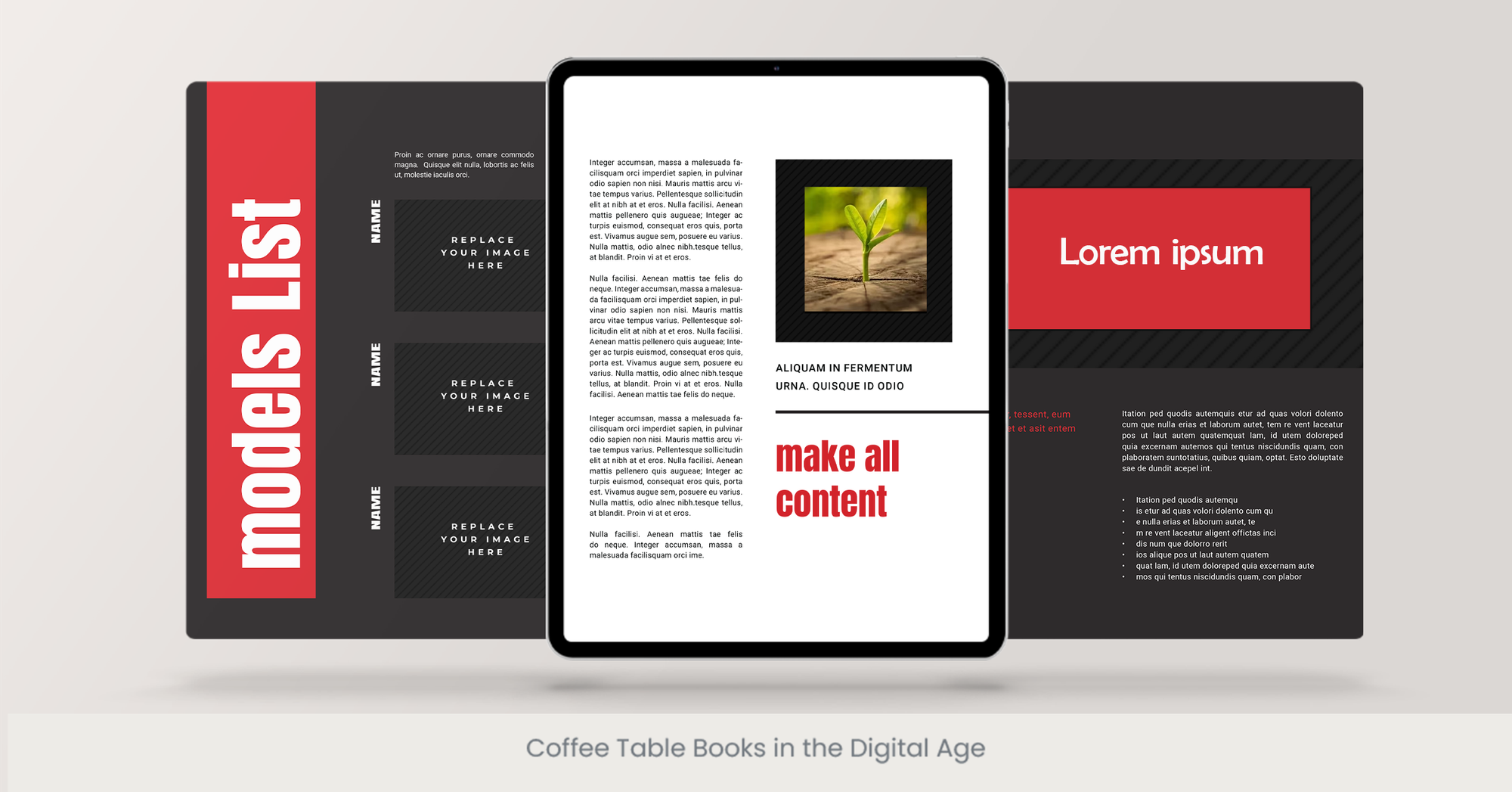
Historical Origins and First Instances

Tracing the Roots: The Emergence of Coffee Table Books
The concept of coffee table books, those large, often opulently illustrated publications designed to be displayed and perused at leisure, has its origins in a blend of art, literature, and social culture. Historically, these books have served not just as sources of information but as decorative objects, intended for casual reading and visual enjoyment. The earliest instances of what one might consider a "coffee table book" date back to the late 19th and early 20th centuries when books became more accessible to the middle class, and the idea of showcasing beautiful books in living spaces gained popularity. These coffee table book printing services allowed publishers to create high-quality, visually stunning books, paving the way for what we know today as iconic coffee table books.
The Literary Revolution: Books as Decor and Discourse
The backdrop against which coffee table books rose to prominence is intertwined with the evolution of printing technologies and the burgeoning art movements of the time. These advancements made it possible to produce books with high-quality photographic reproductions, intricate illustrations, and elaborate bindings, thereby elevating the aesthetic and tactile appeal of books. The Art Deco and Modernist movements, in particular, played significant roles in shaping the creative coffee table book design sensibilities of early coffee table books, making them not only repositories of knowledge but also symbols of cultural sophistication and artistic taste.
From Curiosity to Icon: Celebrated Examples and Pioneering Works
The lineage of iconic best-selling coffee table books is dotted with landmark publications that have set the standards for beauty, quality, and cultural significance. One of the earliest and most celebrated examples is "Les Merveilles de la Coloration Moderne," a visual feast of color theory and application published in 1914. This book, with its lavish illustrations and groundbreaking print quality, encapsulated the essence of what coffee table books would come to represent: artistry, education, and leisurely exploration. Similarly, "Birds of America" by John James Audubon, though published earlier in the 19th century, became a prized possession for its detailed and vibrant avian illustrations, hinting at the future potential of coffee table books as collectible works of art.
Evolution of Content: From Art to Diverse Topics

Broadening Horizons: The Diversification of Coffee Table Books
The evolution of coffee table books from predominantly art and photography collections to encompass a wide array of subjects reflects broader cultural and societal shifts. Initially, these books served as showcases for artistic masterpieces and photographic expeditions, making art accessible to a wider audience beyond the confines of galleries and museums. However, as the 20th century progressed, publishers began to recognize the potential of coffee table books to cover a broader range of topics. This expansion was driven by increasing public interest in diverse subjects such as travel, fashion, architecture, design, and even gastronomy. This diversification has transformed coffee table books into comprehensive visual narratives that capture the essence of their subject matter in a way that is both informative and aesthetically pleasing, with engaging content for coffee table books appealing to all tastes and interests.
From Galleries to Global: Capturing a World of Subjects
The journey of coffee table books through the 20th century is marked by the gradual inclusion of various themes and subjects. Iconic titles such as "The Family of Man," a photography book curated by Edward Steichen for the Museum of Modern Art in New York, showcased the power of photography to narrate the human experience across different cultures and societies. This book set a precedent for coffee table books as mediums for storytelling, bridging geographical and cultural divides. Similarly, fashion and lifestyle coffee table books like "Vogue: The Covers" trace the history and evolution of fashion through the lens of magazine covers, offering readers both a visual feast and a cultural chronicle, inspiring the coffee table book design inspirations for many to follow.
Real-World Reflections: Iconic Titles and Cultural Milestones
The evolution of coffee table book content is mirrored in titles that have become cultural milestones. For example, "S, M, L, XL" by Rem Koolhaas and Bruce Mau presents a unique take on architectural theory and practice through essays, diary entries, and meditations alongside architectural drawings and photographs. This eclectic mix of content types within a single volume illustrates how coffee table books have become platforms for innovative expression and intellectual exploration. Moreover, books like "The Beatles Anthology," which documents the band's history in their own words, underscore the ability of coffee table books to serve as definitive records of cultural phenomena, paving the way for future best-selling coffee table books.
Rise in Popularity: Factors and Trends

A Cultural Phenomenon: The Ascendance of Coffee Table Books
The rise in popularity of coffee table books can be attributed to a confluence of cultural, technological, and economic factors that transformed them from niche publications into ubiquitous elements of modern living spaces. As the 20th century progressed, improvements in printing technology and mass production methods significantly reduced the costs of producing high-quality, visually stunning books. Concurrently, the burgeoning middle class, with its increased disposable income and appetite for cultural products, found in coffee table books an ideal blend of education, entertainment, and interior decoration. This period saw coffee table books becoming essential components of a well-curated living space, signifying taste, sophistication, and a worldly perspective. These coffee table book printing services allowed for the mass production of these luxurious books at affordable prices, making them accessible to more people than ever before.
The Role of Innovations and Accessibility
The democratization of coffee table books was significantly aided by innovations in printing and distribution. Technological advancements made it possible to reproduce photographs, illustrations, and artworks with unprecedented clarity and fidelity, making these books more appealing to a wider audience. Additionally, the expansion of global distribution networks allowed publishers to market coffee table books to an international audience, further boosting their popularity. The advent of online shopping platforms like Amazon facilitated easy access to a vast array of coffee table books, enabling consumers from around the world to discover and purchase titles that matched their interests and aesthetic preferences.
Trends Shaping Demand: Aesthetics and Identity
One cannot discuss the popularity of coffee table books without acknowledging the influence of aesthetic trends and personal identity. In an era where self-expression and individualism are highly valued, coffee table books serve as extensions of one's personality and style. Whether it's a meticulously arranged stack of fashion titles, a thoughtfully curated collection of travel journals, or a series dedicated to modern art, these books allow individuals to communicate their interests, beliefs, and aspirations. Moreover, the rise of social media platforms has amplified this trend, with visually striking coffee table books often featuring prominently in lifestyle and interior design posts, further cementing their status as cultural icons. For those looking for coffee table book design inspirations, social media has become an invaluable source.
Impact of Digital Media on Popularity

The Digital Paradox: Enhancing and Challenging Traditional Formats
The advent of digital media has significantly impacted the way we consume content, presenting both opportunities and challenges for the traditional coffee table book format. On one hand, digital platforms have provided a new avenue for showcasing and discovering coffee table books. Publishers and authors use social media, digital catalogs, and online reviews to reach a broader audience, increasing visibility and interest in these physical books. Furthermore, digital previews and e-commerce platforms like Amazon have made it easier for consumers to explore and purchase coffee table books, contributing to their sustained popularity despite the digital age.
Bridging the Gap: Coffee Table Books as Tangible Artifacts
While digital media offers convenience and accessibility, it also underscores the unique value of coffee table books as tangible, physical objects. In a world increasingly dominated by screens, coffee table books offer a sensory experience that digital formats cannot replicate. The act of flipping through the pages, feeling the weight of the book, and appreciating the print quality and craftsmanship appeals to our desire for tangible connections and authentic experiences. This contrast has led to a renewed appreciation for coffee table books as objects of art and design, enhancing their status and appeal in contemporary culture. As a result, many book lovers turn to coffee table book printing services to bring their own designs to life, crafting books that are as much about the experience as the content itself.
Synergy Between Digital and Print: A New Ecosystem
Interestingly, digital media has not only coexisted with coffee table books but has also played a role in their evolution. Online platforms have become vital tools for discovering and sharing content, with hashtags and social media trends often driving interest in specific books or topics. Digital influencers and lifestyle bloggers frequently feature coffee table books in their content, creating buzz and influencing trends. This synergy between digital and print has created a new ecosystem where each medium enhances the value of the other, contributing to the ongoing popularity and relevance of coffee table books in a digital age.
Iconic Coffee Table Books Through the Decades

Timeless Treasures: Defining Iconic Coffee Table Books
Over the decades, certain coffee table books have transcended their initial publication status to become cultural icons, cherished for their beauty, depth, and impact. These books often encapsulate the essence of an era, offering insights into artistic movements, societal trends, or natural wonders through stunning visuals and compelling narratives. From pioneering works that introduced the concept of the coffee table book to modern editions of favorites that continue to push creative boundaries, these publications have a lasting place in the annals of print media. Whether it's the engaging content for coffee table books or the stunning visuals, these books demonstrate how creative coffee table book design can elevate the medium to a whole new level.
Pioneers and Trailblazers: The Books That Set the Standard
One cannot discuss iconic coffee table books without mentioning "Sumo" by Helmut Newton, a revolutionary publication that redefined what a coffee table book could be. Released in 1999, its unprecedented size and scale, coupled with Newton's provocative photography, made it an instant classic. Similarly, "The Beatles Anthology," which offered an intimate look into the lives of the Fab Four through personal narratives and rare photographs, became a must-have for music enthusiasts and historians alike. These works, among others, have set the standard for what constitutes an iconic coffee table book: a publication that not only captures the imagination but also embodies the spirit of its time. Best-selling coffee table books like these show how an eye-catching design paired with engaging content can leave a lasting mark on the cultural landscape.
Looking to create your own coffee table book? Let’s connect!
Evolution and Expansion: Broadening the Scope
As the concept of the coffee table book evolved, so too did the range of topics it covered. "Vanity Fair 100 Years" chronicles a century of iconic culture, politics, and personalities as captured by the magazine, offering a visual and editorial feast that appeals to a wide audience. On the environmental front, "Planet Earth" brings breathtaking natural landscapes into homes, inspiring awe and a deeper appreciation for the natural world. These titles exemplify how coffee table books have expanded beyond art and photography to encompass history, science, lifestyle, and more, broadening their appeal and impact. This evolution shows the importance of creative coffee table book design and how it adapts to new genres and trends.
Publishing Milestones in Coffee Table Book History

Setting the Stage: The Birth of a Genre
The journey of coffee table books from niche to mainstream is marked by several publishing milestones that have shaped the evolution of this distinctive genre. The concept of a "coffee table book," while not new, gained significant traction in the mid-20th century when publishers began to experiment with books that were as much about art and visual appeal as they were about reading. One of the earliest and most significant milestones was the publication of "Birds of America" by John James Audubon in the 19th century. Although not a coffee table book in the contemporary sense, its lavish illustrations and substantial format laid the groundwork for the visually driven books that would follow. Many of these early books set the foundation for modern coffee table book printing services, establishing a new standard in the publishing world.
Breakthrough Moments: Innovations and Iconic Releases
The release of "The Family of Man" in 1955 stands as a pivotal moment in coffee table book history. Curated by Edward Steichen for the Museum of Modern Art in New York, this photographic exhibition catalog became one of the first books to be recognized for its artistic as well as its book design merits, setting a precedent for future publications. Another landmark publication, "Life: The First Fifty Years," captured the essence of mid-20th-century photojournalism, compiling iconic images from the magazine's history into a single, compelling volume. These publications not only showcased the potential of the coffee table book format but also demonstrated how books could serve as important cultural artifacts. These historical milestones underscore the importance of best-selling coffee table books, which often become cultural landmarks.
Technological Advances: Enhancing Quality and Reach
Advancements in printing technology have played a crucial role in the development of coffee table books. The introduction of digital printing and improved binding techniques in the late 20th and early 21st centuries allowed for higher quality reproductions and more ambitious designs. These technological innovations made it possible to produce books with unparalleled visual clarity and detail, making them more appealing to both publishers and readers. The rise of online retail platforms further democratized access to coffee table books, enabling small publishers and independent authors to reach a global audience and contribute to the diversity of the genre. This evolution also contributed to the growing demand for creative coffee table book design and coffee table book printing services that support innovative ideas and visions.
Ready to bring your coffee table book to life? Get in touch.
The Role of Celebrity and High-Profile Authors

Stars of the Page: Celebrities as Authors and Subjects
The involvement of celebrities and high-profile authors has significantly influenced the coffee table book market, transforming these publications into coveted items. Whether by offering an intimate glimpse into the lives of the rich and famous or by showcasing a celebrity's creative talents, these books leverage the star power of their subjects or authors to attract attention and sales. For instance, Annie Leibovitz's "A Photographer's Life: 1990-2005" collection provides not only a showcase of her formidable photography skills but also an insider look at celebrity culture, blending characters' personal and public personas in a compelling visual narrative. The rise of best-selling coffee table books centered around celebrities shows how the allure of famous names can drive sales and elevate the genre to new heights.
Beyond the Glamour: Depth and Authenticity
While the allure of celebrity can certainly draw readers, the best coffee table books offer more than just surface appeal. They provide depth, insight, and an authentic voice that can make the world of the celebrity accessible and relatable. "Becoming" by Michelle Obama, though not a traditional coffee table book, has been celebrated for its candidness and has been included in many coffee table book collections for its inspirational narrative and stunning visuals. Similarly, "Rihanna" by Rihanna offers a visual autobiography of the artist, filled with intimate photographs and insights, allowing fans a closer look at her journey.
The Impact on Sales and Visibility
The involvement of celebrities and high-profile authors can have a substantial impact on the sales and visibility of coffee table books. Their ability to generate media buzz and utilize social media platforms effectively can catapult a coffee table book into the spotlight, significantly increasing its reach and appeal. The success of books like "The Selby Is in Your Place" by author Todd Selby, which features creative individuals in their personal spaces, underscores the public's interest in the lifestyles and interiors of the culturally influential, further boosted by celebrity endorsements and features.
Trends in Coffee Table Book Publishing

Embracing Diversity and Inclusivity
One of the most noteworthy trends in coffee table book publishing is the move towards greater diversity and inclusivity. Publishers are increasingly showcasing a wide array of voices, perspectives, and experiences, reflecting a broader societal shift towards recognizing and celebrating cultural diversity. Books like "The Atlas of Beauty" by Mihaela Noroc, which features portraits of women from over 50 countries, underscore this trend, challenging traditional notions of beauty and offering a global perspective that is both enlightening and inspiring. This trend has contributed to an increase in creative coffee table book design that reflects a wider variety of cultural experiences and voices.
Sustainable and Ethical Publishing Practices
Sustainability has become a key concern for publishers and consumers alike, leading to a surge in interest in environmentally friendly printing practices and materials. Coffee table books are now more frequently produced using recycled paper, soy-based inks, and other sustainable resources. Moreover, publishers are more transparent about their environmental impact, often sharing details about their sustainability efforts in the book's colophon or on a page of their websites page. This shift not only appeals to eco-conscious readers but also aligns with a broader commitment to environmental stewardship. As sustainability becomes a greater focus, coffee table book printing services are evolving to meet the demand for eco-friendly options.
The Rise of Niche Topics and Personalization
The digital age has brought with it a fragmentation of interests, with niche markets and subcultures gaining prominence. Coffee table book publishers have tapped into this trend by producing books on highly specialized topics that cater to specific interests and hobbies. From books dedicated to the art of Japanese whisky-making to volumes exploring the world of boutique pedal manufacturers, the range of subjects has never been broader or more eclectic. Additionally, the option to add something for personalization, such as custom covers or inscribed editions with pictures, adds a layer of exclusivity and personal touch that enhances the appeal of coffee table books as gifts or keepsakes. This personalization trend highlights the importance of creative coffee table book design and the ability to create tailored books that resonate with specific audiences.
Coffee Table Books in the Digital Age

Navigating the Digital Landscape
The digital age has presented both challenges and opportunities for coffee table books, a genre traditionally rooted in physicality and visual appeal. While the rise of digital media has shifted consumer habits towards screens, coffee table books have carved out a unique niche by emphasizing the tactile and aesthetic experiences that digital formats cannot replicate. Publishers have navigated this landscape by leveraging online platforms to enhance their work' visibility and reach, utilizing social media, digital marketing, and e-commerce to connect their work with a global audience and drive interest in physical books. This shift also influences coffee table book printing services, which are adapting to meet the needs of a digitally connected world.
Synergy Between Print and Digital
Rather than competing with digital media, coffee table books have found ways to coexist and even complement digital experiences. Publishers are increasingly incorporating digital elements into their offerings, such as online galleries, interactive content, and virtual reality experiences that extend the book's themes and visuals beyond its pages. This synergy allows readers to engage with the content in multiple dimensions, enriching their understanding and appreciation of the subject matter. For instance, a coffee table book about space exploration might include QR codes that link to immersive space simulation videos, enhancing the reader's experience by combining print and digital media. These innovations further exemplify how creative coffee table book design is expanding beyond traditional formats.
The Role of E-Books and Digital Editions
While the essence of coffee table books lies in their physical form, the availability of digital editions has made them more accessible to a wider audience. Digital editions can offer additional features such as zoom capabilities for detailed artwork and hyperlinks to external resources, providing a complementary experience to the physical book. However, these also means that digital versions are often seen as supplements rather than replacements, underscoring the irreplaceable value of the tangible book as an object of art, design, and a means of personal expression. As best-selling coffee table books continue to find success in digital formats, their physical counterparts will remain an essential part of the experience.
Stay ahead in publishing trends. Read our latest guides now
Future Prospects: Sustainability and Innovation
Embracing a Sustainable Future
The future of coffee table books is increasingly being shaped by a growing consciousness around sustainability and environmental responsibility. Publishers are exploring more eco-friendly production methods, including the use of recycled materials and renewable energy sources in the manufacturing process. This shift is not only a response to consumer demand for more sustainable products but also reflects a broader industry commitment to reducing environmental impact. As these practices become more prevalent, they are likely to set new standards for coffee table book printing services, ensuring that the beauty of coffee table books does not come at the expense of the planet.
Innovation in Content and Design
Innovation continues to drive the evolution of coffee table books, with publishers and creators experimenting with new formats, materials, and interactive elements. From books that incorporate cutting-edge printing techniques to create never-before-seen visual effects to those that integrate digital components for an enhanced reading experience, the potential for innovation is boundless. These advancements not only enrich the reader's engagement with the book but also push the boundaries of what coffee table books can be, opening up new possibilities for storytelling and visual communication. As the genre evolves, coffee table book design inspirations will continue to shape the future of the medium.
Looking for creative design inspirations? Check out our work.
The Role of Collaboration and Community
The future of coffee table books also lies in fostering collaboration and community. Publishers are increasingly partnering with artists, photographers, writers, and communities to tell diverse and compelling stories that resonate with a wide audience. These collaborations can bring fresh perspectives and voices to the forefront, enriching the coffee table book landscape with stories that might otherwise remain untold. Moreover, the rise of crowdfunding platforms has democratized the publishing process, enabling independent creators to bring their vision to life with the support of a global community. This spirit of collaboration will drive the continued success of best-selling coffee table books that captivate audiences around the world.
Discover sustainable design solutions for your next coffee table book.
FAQs about Coffee Table Books
Is there really a coffee table book about coffee tables?
Yes, there is indeed a coffee table book about coffee tables, made famous by the fictional character Cosmo Kramer from the TV show "Seinfeld." This concept became iconic, blending humor with the meta-concept of a book about the furniture it's destined to adorn. While Kramer's book is fictional, it has inspired real-life published versions and discussions about the versatility of both coffee tables and table books.
What is the concept of a coffee table book?
A coffee table book is a large, often lavishly illustrated book designed to be displayed and enjoyed for its aesthetic appeal and informative content. These books typically cover a wide range of topics, from art and photography to home, to travel and fashion, and are intended to engage visitors, spark conversations, and add to the decor of a home or living space.
What is another name for a coffee table book?
Coffee table books are sometimes referred to as "oversized books" or "display books" due to their large size and the author' intention for them as display and to be placed on a table or shelf where they can be easily seen and accessed by guests.
Do people still use the coffee tables and table books?
Absolutely. Despite the digital age, coffee table books remain popular for their visual appeal, quality of printing, and the tangible experience they offer. They serve as conversation starters, sources of inspiration, and decorative objects, continuing to find a place in homes, offices, and commercial spaces alike.



%20(1).jpg)
%20(1).jpg)


